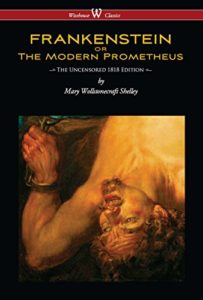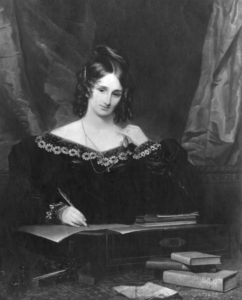
I was seven years old when a late Saturday night television program called House of Shock began broadcasting in New Orleans. It was hosted by a character named Morgus the Magnificent, a mad scientist aided by his two assistants, Chopsley (tall, hooded, and never speaking) and Eric, the talking skull. Morgus showed old horror and science fiction movies in between clips of his crazy experiments, and (at least to a seven-year-old and his older brother) he was just as entertaining as the movies.
One of those movies was the 1931 version of Frankenstein, starring Boris Karloff as the monster. That movie framed the Frankenstein legend in my head for more than 50 years. This year, I saw that it was the novel’s 200th birthday (officially on Jan. 1), and I decided to read the original Frankenstein, or the Modern Prometheus by Mary Wollstonecraft Shelley.
I was in for a shock.
 The book bears virtually no resemblance to the movie. It falls clearly in the genre of Gothic fiction, which started in 1764 with Horace Walpole’s The Castle of Otranto and was widely popular in the 19th century, especially the Romantic period. Common characteristics for Gothic fiction include a romance, a family curse, occasional ghosts in haunted castles or mansions, lots of storms, and what we would call “high melodrama” today. Shelley’s Frankenstein is all of these things, but it is not what we know from the movies.
The book bears virtually no resemblance to the movie. It falls clearly in the genre of Gothic fiction, which started in 1764 with Horace Walpole’s The Castle of Otranto and was widely popular in the 19th century, especially the Romantic period. Common characteristics for Gothic fiction include a romance, a family curse, occasional ghosts in haunted castles or mansions, lots of storms, and what we would call “high melodrama” today. Shelley’s Frankenstein is all of these things, but it is not what we know from the movies.
Robert Walton, an Englishman in the late 1700s, has commissioned a ship to explore the arctic regions, especially the area between Russia and the Arctic Circle. He tells the story in a series of letters to his sister. One day, as the ship is stuck in ice, he and his crew see in the distance an extremely large figure driving a dog sled. The next day, they rescue another sled driver, who is chasing the first.
This is a man named Viktor Frankenstein, a native of Geneva. He tells a strange and bizarre story about the figure he is chasing. The figure he is chasing is his own creation, an ogre-like creature who has killed Frankenstein’s young brother, his best friend, and his wife, all because Frankenstein will not create a mate for his creature (a hint of the origin of the movie sequel, The Bride of Frankenstein, in 1935).
The creature is never named in the story, but he proves to be highly intelligent, reading books, learning languages, and trying to reach out to people he thinks might accept him. But his appearance is too shocking, evoking immediate fear and horror. Frankenstein at first agrees reluctantly to the creature’s demand for a mate. Then he realizes what he will be doing, and he destroys the creation in progress. Mayhem ensues.
The story ranges from Geneva and the Swiss Alps to Germany, the Rhine valley, England, Scotland, the Orkney Islands, and Ireland before returning to Geneva. And then it’s on to Russia and the Arctic. Walton, the ship captain, keeps a journal of his conversations with Frankenstein.

Mary Shelley
The idea of the story began in a villa on Lake Geneva, among a group that included George Gordon Lord Byron, Mary Shelley and her husband Percy, and Byron’s young physician, John Polidori. During a rainstorm, Byron suggested a competition to the group: Who could write the best ghost story? Byron and Percy Shelley would soon lose interest; Mary Shelley started writing what would become Frankenstein, and Polidori created what would become the first published vampire story, initially attributed to Byron and later corrected. (Andrew McConnell Stott has an in-depth account of what happened that summer in his 2014 book The Poet and the Vampyre: The Curse of Byron and the Birth of Literature’s Greatest Monsters.)
Frankenstein was heavily influenced by the Greek myth of Prometheus, who was credited with creating humanity from clay and a far worse offense: giving humanity the gift of fire. Zeus punished him with eternal torment of the soul. Shelley’s Viktor Frankenstein is indeed a modern Prometheus, suffering physical and emotional anguish over what he has created and watching his family and hopes for happiness destroyed. This Promethean theme reflects the Romantic period’s unease with science and technology, an unease that is still very much with us today.
The book is relatively short. It is also filled with long discussions and discourses on humanity, literature, culture, and the need for social interaction and relationships. It is a Gothic tragedy about how an act of creation and invention leads to unimagined and terrible consequences.
Frankenstein may be 200 years old, but its core theme still speaks to us today.
Related:
If you live in the Nashville, Tenn., area, Studio Tennessee is staging a new version of Frankenstein, based on Shelley’s novel and adapted by A.S. Peterson. The play runs from Aug. 31 to Sept. 9. Peterson is interviewed about the play at The Rabbit Room, Part 1 and Part II.
What Frankenstein means now — Jack Stilgoe at The Guardian
Photo by Marco Verch, Creative Commons, via Flickr. Post by Glynn Young, author of Poetry at Work and the novels Dancing Priest, A Light Shining, and the newly published Dancing King.
__________________________

“I require all our incoming poetry students—in the MFA I direct—to buy and read this book.”
—Jeanetta Calhoun Mish
- Poets and Poems: Sandra Marchetti and “Diorama” - April 24, 2025
- Poets and Poems: Christina Cook and “Roaming the Labyrinth” - April 22, 2025
- Longfellow’s “Paul Revere’s Ride”: Creating a National Legend - April 17, 2025
Megan Willome says
I read the book for the first time about 20 years ago and was just astounded at how contemporary it is. With all the technological advances in the last two decades, I’d say it’s even more relevant.
Earlier this year NPR’s “Science Friday” dedicated their book club to “Frankenstein.” There are lots of great discussions, but this one is my favorite, when a tenth-grader calls in for help with a paper. https://www.sciencefriday.com/segments/please-call-me-back-its-about-frankenstein/
L.L. Barkat says
I loved this book and was astonished, when I read it long ago, that a 21-y-o had written it. I love your succinct summary! (The movie does look so different, based on the trailer. I’ve never seen it. 🙂 )
J says
Interesting post. Of course, my first introduction to Frankenstein was Mel Brooks’ Young Frankenstein with Gene Wilder, so imagine how warped my view is (lol). The Andrew McConnell Stott book sounds like something I’d be interested in checking out.